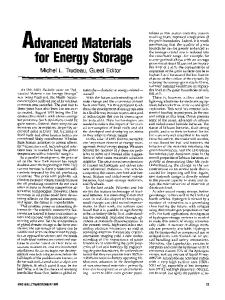Advanced Materials to the Fore Materials Requirements for Golf Clubheads
- PDF / 2,538,849 Bytes
- 4 Pages / 576 x 777.6 pts Page_size
- 46 Downloads / 326 Views
anelasticity must be considered. Anelastic effects are sources of internal friction and the so-called damping capacity of materials. It is well-known that the closed loop area in the stress-strain diagram of a cyclically loaded specimen gives the energy dissipated per cycle (Figure 2). This loop is formed because the strain cycle lags behind the stress cycle. The larger the closed loop, the larger the energy dissipated. The specific damping capacity is measured by the ratio of the energy dissipated per cycle, AVY to the energy applied, W, and is equal to tan y, where y is the phase angle that measures this lag. Therefore, the larger the phase lag angle, the larger the energy dissipated.22 That is,
Advanced Materials to the Fore Materials Requirements for Golf Clubheads S.K. Liu The special properties of advanced materials have prompted manufacturers to consider their use in sports equipment— particularly in golf clubs. The International Golf Association permits golfers to use clubheads with different facing materials inserted into the head body. As a result, clubheads made from stainless steel, aluminum alloys, and zinc alloys now face competition from those made of advanced materials and from those with various advanced materials inserted into the head body as the striking face. Golf clubheads have specific materials properties requirements, but these requirements are less harsh than those required for the aerospace and transportation industries. So, advanced materials can be used in manufacturing golf clubheads without extensive property certification. Maybe this is one reason so many different kinds of clubheads made from different materials have appeared on the market recently, although some of the new varieties are falsely advertised and cannot withstand the demands placed on them during service. This article offers an analysis from a metallurgist's point of view of the main characteristics of clubheads made from advanced materials.
Modulus of Elasticity and Damping Capacity Since neither the golf clubhead nor the ball are rigid bodies, elastic deformation of the clubhead cannot be avoided when the club strikes the ball. Therefore, the analyses of stress and strain produced in a clubhead during striking are complex. Let us analyze the process of a clubhead striking a ball. For simplicity, the impact response of a clubhead can be described as that of a flexible target. According to Greszczuk,1 an approximate solution for the impact response of a flexible plate-type target can be obtained by considering the deformations
MRS BULLETIN/NOVEMBER 1993
AW E" ^ " t a n
shown in Figure 1. The relationship between the force and deflection has the form P = K8
(1)
where S is the bending deformation and K is the spring constant, which can be given as the following if we treat the striking face of the clubhead as a circular isotropic plate of radius, R, and thickness, h, clamped along the outer boundary : P_ 4-n-E/i3 ~ S ~ 3(1 - v2)R2
(2)
where £ and v are the Young's modulus and Poisson's ratio, respectively. It is
Data Loading...











